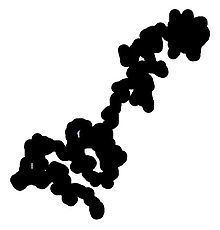 | ||
Kleiner kauf wiener sausage w rstchen
In the mathematical field of probability, the Wiener sausage is a neighborhood of the trace of a Brownian motion up to a time t, given by taking all points within a fixed distance of Brownian motion. It can be visualized as a sausage of fixed radius whose centerline is Brownian motion. The Wiener sausage was named after Norbert Wiener by M. D. Donsker and S. R. Srinivasa Varadhan (1975) because of its relation to the Wiener process; the name is also a pun on Vienna sausage, as "Wiener" means "Viennese" in German.
Contents
- Kleiner kauf wiener sausage w rstchen
- Japanese wiener sausage
- Definitions
- The volume of the Wiener sausage
- References
The Wiener sausage is one of the simplest non-Markovian functionals of Brownian motion. Its applications include stochastic phenomena including heat conduction. It was first described by Frank Spitzer (1964), and it was used by Mark Kac and Joaquin Mazdak Luttinger (1973, 1974) to explain results of a Bose–Einstein condensate, with proofs published by M. D. Donsker and S. R. Srinivasa Varadhan (1975).
Japanese wiener sausage
Definitions
The Wiener sausage Wδ(t) of radius δ and length t is the set-valued random variable on Brownian paths b (in some Euclidean space) defined by
The volume of the Wiener sausage
There has been a lot of work on the behavior of the volume (Lebesgue measure) |Wδ(t)| of the Wiener sausage as it becomes thin (δ→0); by rescaling, this is essentially equivalent to studying the volume as the sausage becomes long (t→∞).
Spitzer (1964) showed that in 3 dimensions the expected value of the volume of the sausage is
In dimension d at least 3 the volume of the Wiener sausage is asymptotic to
as t tends to infinity. In dimensions 1 and 2 this formula gets replaced by
